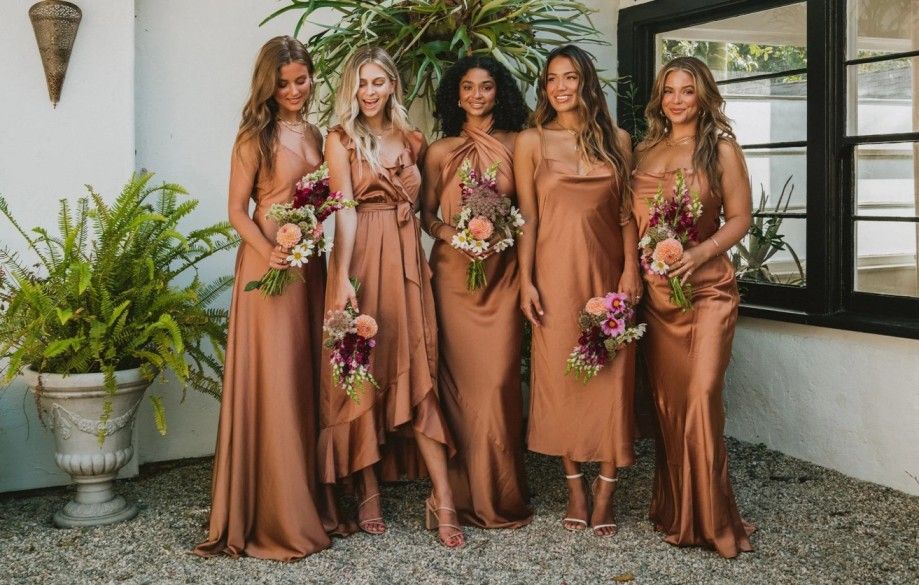When someone is appointed a bridesmaid, one of the many decisions involved is: what will the bridesmaid wear? The term “bridesmaid outfit” covers the dress (or gown) and sometimes coordinating accessories chosen by the wedding party or the couple. These outfits exist because weddings traditionally include a bridal party whose members provide support and take part in the ceremony; dressing them in a coordinated way helps create cohesion in photographs and in the visual style of the event.
Over time, the concept of bridesmaid outfits has evolved—moving from strictly matching dresses in identical styles to more flexible, individual-friendly options.

Importance
Why does choosing a bridesmaid outfit matter today, who it affects, and what problems it solves?
Who it affects:
-
The person getting married and their preferences for how the wedding party looks.
-
The bridesmaids who must select or wear an outfit that fits the event, complements the wedding theme, and suits their body type and style.
-
Wedding planners, stylists, and coordinators who provide advice and ensure the overall aesthetic stays consistent.
What problems it helps solve:
-
Visual harmony: It ensures the bridal party looks unified or intentionally coordinated with the overall wedding decor or tone.
-
Comfort and fit: Choosing an outfit early allows time for tailoring, ensuring comfort and confidence throughout the event.
-
Budget and reuse: A well-chosen bridesmaid dress can be worn again or adapted for future events, promoting sustainability.
-
Time management: Agreeing on style, colour, and fabric early avoids last-minute stress and mismatches.
In short, a thoughtful approach to bridesmaid outfits helps ensure everyone involved feels prepared, comfortable, and aligned with the wedding’s aesthetic.
Recent Updates
In the past year, several notable shifts have emerged in bridesmaid outfit trends.
-
There is a clear move away from everyone wearing the same dress toward more flexible and personalized styles.
-
Colour palettes are expanding—soft pastels, muted neutrals, bold florals, and deep jewel tones are among the most popular choices for 2025.
-
Mismatched bridesmaid dresses, featuring different silhouettes or fabrics within a unified palette, are gaining popularity.
-
Sustainability and re-wearability are increasingly important, with bridesmaids choosing dresses that can be worn for other occasions.
-
Modern fabrics like satin, chiffon, and metallics are trending, along with design elements such as puff sleeves, one-shoulder cuts, and minimalist lines.
These updates show that bridesmaid outfits are evolving toward personalization, sustainability, and creative expression rather than rigid uniformity.
Laws or Policies
While bridesmaid outfits are a fashion matter, certain rules and regulations indirectly affect the process, depending on the country:
-
Consumer rights and returns: Purchases of dresses are covered under consumer protection laws, which ensure quality, accurate description, and fair return policies.
-
Ethical manufacturing: Many modern brides and planners prioritize ethically made clothing, in line with labour laws and sustainability standards.
-
Import duties and customs: For international orders, taxes and import duties may apply, especially when dresses are sourced abroad.
-
Venue and ceremony regulations: Some venues or religious ceremonies have dress codes regarding modesty, sleeve length, or fabric type that bridesmaids must follow.
-
Equality considerations: Ethical concerns may arise if a bridesmaid is asked to spend excessively beyond her means. Clear communication and fairness help maintain harmony.
These factors ensure that the process of selecting bridesmaid outfits remains fair, compliant, and respectful of both laws and participants.
Tools and Resources
Here are practical tools and resources that help in planning and coordinating bridesmaid outfits:
-
Mood boards and visual planners: Use digital platforms to collect and compare outfit ideas, fabrics, and accessories.
-
Dress size and fit calculators: Available on many bridal fashion websites to help ensure accurate measurements.
-
Colour palette generators: Tools like online colour visualizers help visualize combinations and themes.
-
Coordinator templates: Shared documents can track each bridesmaid’s size, deadlines, and alteration progress.
-
Checklists: A structured list of steps—from choosing a style to final fitting—keeps planning organized.
-
Wedding fashion forums: Online communities provide first-hand experiences and styling advice.
-
Dress rental or sharing platforms: Allow for more sustainable options and reduce wardrobe waste.
-
Accessory coordination tools: Apps and websites that match jewellery, shoes, and wraps with the outfit’s style and colour.
These tools simplify the process of organizing bridesmaid outfits and help the entire wedding party stay on schedule and in sync.
FAQs
What is a typical timeline for bridesmaid dress selection?
Most couples finalize dress palettes 4–6 months before the wedding. Bridesmaids usually order dresses 10–12 weeks in advance and complete final fittings about a month before the event.
Should all bridesmaids wear the same dress?
Not necessarily. Current trends favour coordinated but not identical looks, where each bridesmaid can choose a cut or fabric that flatters her body type while maintaining colour harmony.
How can a bridesmaid ensure the dress will be re-wearable?
Choose timeless designs and neutral tones that suit both the wedding and future semi-formal events. Avoid overly themed embellishments to make reuse easier.
What factors should bridesmaids consider for comfort and style?
Focus on fabric breathability, sleeve and neckline comfort, mobility for dancing or walking, and compatibility with accessories or cover-ups.
How do budget concerns influence outfit choices?
Being transparent about price expectations early avoids financial strain. Consider shared costs, rental options, or styles that can be reused to maximize value.
Conclusion
Selecting bridesmaid outfits involves balancing style, comfort, individuality, and coordination. With modern trends emphasizing flexibility, re-wearability, and inclusive colour palettes, today’s bridesmaid fashion reflects creativity and practicality. Careful planning, attention to comfort, and use of available digital tools make the process smoother and more enjoyable for everyone involved. The result is a cohesive yet personalized wedding look that supports the spirit of the celebration—unity with individuality.